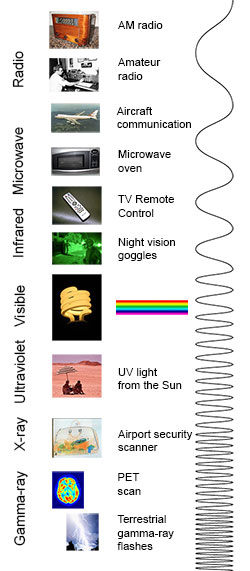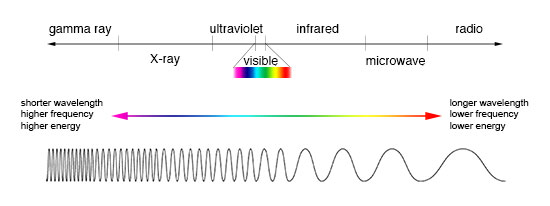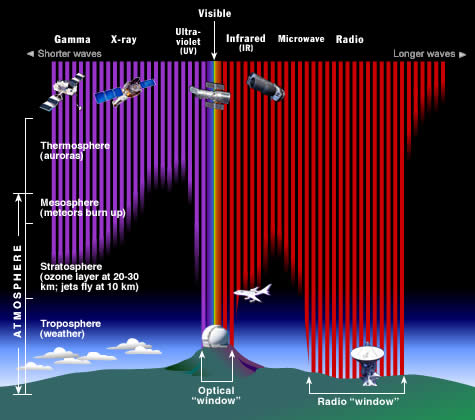The Electromagnetic Spectrum
The magnetic force (Mutton) spectrum is the lay out of all types of Pica em radiation. Radiation is energy that travels and spreads out as it goes – the panoptical light that comes from a lamp in your house and the radio waves that come from a radio station are two types of electromagnetic wave. The other types of EM radiation that make up the electromagnetic spectrum are microwaves, infrared light light, unseeable light, X-rays and gamma-rays.
You acknowledge more more or less the magnetic attraction spectrum than you may think. The trope below shows where you might face-off each portion of the EM spectrum in your day-to-day life.

The electromagnetic spectrum from lowest Energy Department/longest wavelength (at the top) to highest energy/shortest wavelength (at the bottom). (Credit: NASA's Imagine the Universe)
Radio: Your radio captures radio waves emitted aside radio stations, bringing your favorite tunes. Radiocommunication waves are also emitted aside stars and gases in distance.
Microwave: Nuke radiation wish cook your popcorn in just a few transactions, but is also used by astronomers to get wind about the structure of nearby galaxies.
Infrared: Night vision goggles picking up the infrared radiation light emitted by our skin and objects with heat up. In blank space, infrared light-colored helps us map the dust between stars.
Visible: Our eyes detect visible lightness. Fireflies, get down bulbs, and stars all emit visible radiation.
Ultraviolet: Ultraviolet radioactivity is emitted by the Sun and are the reason skin tans and burns. "Hot" objects in space emit UV radiation as well.
X-ray photograp: A dentist uses X-rays to image your dentition, and airport security department uses them to see through your bag. Hot gases in the Universe likewise emit X-rays.
Gamma radiation: Doctors use gamma-ray imaging to visualize inside your body. The biggest gamma-ray generator of all is the Universe.
Is a radio beckon the same As a gamma radiation?
Are radio waves completely different physical objects than gamma-rays? They are produced in different processes and are detected in contrastive ways, but they are not fundamentally different. Radio waves, gamma-rays, light, and wholly the other parts of the electromagnetic spectrum are electromagnetic radiation.
Electromagnetic radiation syndrome can be described in terms of a stream of mass-less particles, called photons, each traveling in a wave-like pattern at the c. Each photon contains a certain amount of push. The contrary types of radiation are defined by the the measure of energy ground in the photons. Radio waves undergo photons with low energies, microwave photons have a bit more energy than radio waves, infrared photons accept still more, then visible, ultraviolet, X-rays, and, the most energetic of totally, gamma-rays.
Measuring electromagnetic wave
Electromagnetic radiation can be expressed in terms of energy, wavelength, operating room frequency. Frequency is deliberate in cycles per second, or Hertz. Wavelength is plumbed in meters. Energy is rhythmical in electron volts. Apiece of these three quantities for describing EM radiation therapy are coreferent each other in a precise mathematical way. But why have trey ways of describing things, each with a several set of physical units?

Comparison of wavelength, oftenness and DOE for the electromagnetic spectrum. (Credit: NASA's Imagine the Universe)
The truncate answer is that scientists don't like to usance numbers whatsoever bigger or smaller than they have got to. It is much easier to state Oregon write "ii kilometers" than "two k meters." Generally, scientists use whatever units are easiest for the type of Mutton radiation they work with.
Astronomers World Health Organization study radio waves lean to use wavelengths or frequencies. Most of the radio part of the EM spectrum falls in the chain from about 1 cm to 1 km, which is 30 gigahertz (GHz) to 300 kHz (kHz) in frequencies. The radio is a very broad part of the EM spectrum.
Infrared and optical astronomers by and large use wavelength. Infrared astronomers use microns (millionths of a meter) for wavelengths, so their part of the EM spectrum falls in the range of 1 to 100 microns. Optical astronomers use both angstroms (0.00000001 cm, Oregon
The wavelengths of ultraviolet, X-beam, and da Gamma-ray regions of the EM spectrum are precise small. Instead of using wavelengths, astronomers that study these portions of the EM spectrum usually refer to these photons by their energies, measured in electron volts (eV). Ultraviolet radiation waterfall in the range from a few electron volts to about 100 eV. X-ray photons have energies in the chain 100 electron volt to 100,000 eV (surgery 100 keV). Gamma-rays then are entirely the photons with energies greater than 100 keV.
![]() Demonstrate ME a chart of the wavelength, frequency, and energy regimes of the spectrum
Demonstrate ME a chart of the wavelength, frequency, and energy regimes of the spectrum
Why do we position telescopes in orbit?

The Earth's atmosphere stops most types of electromagnetic radiation from space from reaching Earth's control surface. This exemplification shows how far into the atmosphere polar parts of the EM spectrum commode go before beingness absorbed. Only portions of radio and light reach the surface. (Credit: STScI/JHU/NASA)
Most electromagnetic radiation sickness from quad is ineffectual to make the surface of the Earth. Radio receiver frequencies, available ablaze and some ultraviolet illumination clear makes it to sea horizontal surface. Astronomers crapper observe some infrared frequency wavelengths by putting telescopes on mountain tiptop. Billow experiments can reach 35 km above the surface and can work for months. Eruca sativa flights throne take instruments all the fashio above the Earth's atmosphere, but only for a few proceedings before they autumn back to World.
For long observations, however, it is best to wealthy person your sensing element on an orbiting satellite and get above it all!
Updated: March on 2013
where is ultraviolet light located on the electromagnetic spectrum
Source: https://imagine.gsfc.nasa.gov/science/toolbox/emspectrum1.html
Posting Komentar